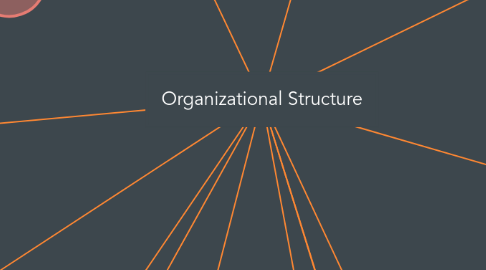
1. Distributing Authority
1.1. Establishing the decision-making hierarchy
1.1.1. deciding who will be empowered to make which decisions and who will have authority over others
1.2. Centralized Organization
1.2.1. organization in which most decision-making authority is held by upper-level management
1.3. Decentralized Organization
1.3.1. organization in which a great deal of decision-making authority is delegated to levels of management at points below the top.
2. The Building Blocks of Organizational Structure
2.1. Specialization
2.1.1. determining who will do what
2.1.2. Job Specialization
2.1.2.1. the process of identifying the specific jobs that need to be done and designating the people who will perform them
2.2. Departmentalization
2.2.1. determining how people performing certain tasks can best be grouped together
2.2.1.1. process of grouping jobs into logical units
2.2.2. Profit Center
2.2.2.1. separate company unit responsible for its own costs and profits
2.2.3. Types
2.2.3.1. Functional Departmentalization
2.2.3.1.1. dividing an organization according to groups’ functions or activities
2.2.3.2. Product Departmentalization
2.2.3.2.1. dividing an organization according to specific products or services being created
2.2.3.3. Process Departmentalization
2.2.3.3.1. dividing an organization according to production processes used to create a good or service
2.2.3.4. Customer Departmentalization
2.2.3.4.1. dividing an organization to offer products and meet needs for identifiable customer groups
2.2.3.5. Geographic Departmentalization
2.2.3.5.1. dividing an organization according to the areas of the country or the world served by a business
3. Tall and Flat Organizations
3.1. Flat Organizational Structure
3.1.1. characteristic of decentralized companies with relatively few layers of management
3.2. Tall Organizational Structure
3.2.1. characteristic of centralized companies with multiple layers of management
4. The Delegation Process
4.1. process through which a manager allocates work to subordinates
4.1.1. Assigning responsibility
4.1.1.1. - the duty to perform an assigned task
4.1.2. Granting authority
4.1.2.1. - the power to make the decisions necessary to complete the task
4.1.3. Creating accountability
4.1.3.1. - the obligation employees have for the successful completion of the task
5. Basic Forms of Organizational Structure
5.1. Functional Structure
5.1.1. organization structure in which authority is determined by the relationships between group functions and activities
5.2. Divisional Structure
5.2.1. organizational structure in which corporate divisions operate as autonomous businesses under the larger corporate umbrella
5.3. Matrix Structure
5.3.1. organizational structure created by superimposing one form of structure onto another
5.4. International Organizational Structures
5.4.1. approaches to organizational structure developed in response to the need to manufacture, purchase, and sell in global markets.
6. Informal Organization
6.1. Informal Organization
6.1.1. network, unrelated to the firm’s formal authority structure, of everyday social interactions among company employees
6.2. Informal groups
6.2.1. groups of people who decide to interact among themselves
7. specification of the jobs to be done within an organization and the ways in which they relate to one another
7.1. Organization Chart
7.1.1. diagram depicting a company’s structure and showing employees where they fit into its operations
7.2. Chain of Command
7.2.1. reporting relationships within a company
8. Determinants of Organizational Structure
8.1. Mission
8.2. Strategy
8.3. Size
8.4. Internal environment
8.5. External environment
9. Span of Control
9.1. number of people supervised by one manager
10. Forms of Authority
10.1. Line Authority
10.1.1. organizational structure in which authority flows in a direct chain of command from the top of the company to the bottom
10.2. Staff Authority
10.2.1. authority based on expertise that usually involves counseling and advising line managers
10.3. Staff Members
10.3.1. advisers and counselors who help line departments in making decisions but who do not have the authority to make final decisions
10.4. Committee and Team Authority
10.4.1. authority granted to committees or teams involved in a firm’s daily operations
10.5. Work Team
10.5.1. group of operating employees who are empowered to plan and organize their own work and to perform that work with a minimum of supervision
11. Organizational Design for the Twenty-First Century
11.1. Team organization
11.1.1. relies almost exclusively on project-type teams, with little or no underlying functional hierarchy
11.2. Learning organization
11.2.1. works to facilitate the lifelong learning and personal development of all of its employees while continually transforming itself to respond to changing demands and needs
11.3. Virtual organization
11.3.1. has little or no formal structure
11.3.2. has only a handful of permanent employees, a very small staff, and a modest administrative facility

